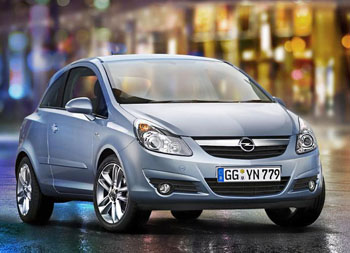

 |
|
Fiat CEO Sergio
Marchionne sees economies of scale to be
achieved by widespread platform sharing
between Fiat and Opel. This strategy would
include the A-segment Opel Agila (bottom),
B-segment Opel Corsa (top) and C-segment
Opel Astra (middle). |
|
|
|
Fiat CEO
Sergio Marchionne is in Germany today outlining
ambitious plans to spin Fiat Group Automobiles out of
the Fiat Group and merge it with GM's Vauxhall/Opel
division and its 20 percent stake in Chrysler. Marchionne
will be making his case today to German government
ministers as well as the key union leaders at Opel for
the creation of a new carmaker that
will be second only to VW Group in Europe in terms of
size.
The Fiat
boss will outline his ambitious strategy to create a new
carmaking giant this afternoon in Berlin in front of
Frank-Walter Steinmeier, the German Vice-Chancellor,
and Karl-Theodor zu Guttenberg, the Economy Minister, while
also present at the meeting will be Klaus Franz, the Co-Chairman of
Opelís supervisory board and head of its works council.
Last week. Taking a stake in Opel could result in the
German government offering up to 3.3 billion euros in
loans. Marchionne said that Opel was an "ideal partner".
Marchionne,
who has turned Fiat's fortunes around since he took
charge five years ago, has long made it clear that he
sees the need for a carmaker to be able to produce more
than six million vehicles a year in order to
achieve the required economies of scale to be
profitable. Merging Fiat's auto division (which
comprises of the Fiat, Fiat Professional, Lancia, Alfa Romeo
and Abarth divisions) with GM's European manufacturing
operations (Vauxhall, Opel and possibly Saab) plus
Fiat's stake in Chrysler would create a company with
around US$106 billion in annual revenues and sales of
6-7 million vehicles a year. The resulting entity would
be bigger than
Ford, GM or Renault/Nissan and only Toyota globally
would have a bigger reach.
Marchionne
believes that merging Fiat with Opel would create a new
car manufacturer that would be a "perfect fit",
despite widespread fears emanating from the German company's unions that it
could result in massive job cuts and plant closures.
ďFrom an engineering and industrial point of view, this
is a marriage made in heaven," he told Financial Times
today in an interview.
Marchionne said Fiat and Opel
would achieve cost saving of around 1 billion euros a year by merging
their B- and C- segment platforms as well as amalgamating Fiat's
A-segment platform, that underpins the Panda and 500, with
Opel's similar size architecture. Fiat and Opel already
share platforms and engines across B-segment (the Fiat Grande
Punto and Opel/Vauxhall Corsa) as the legacy of a
previous agreement. "Itís an incredibly simple solution
to a very thorny problem," Marchionne told FT.
According to
FT Marchionne plans that the new group,
tentatively called Opel/Fiat, will be publically listed, possibly as
early as later this month. He has often said that he
would spin Fiat's carmaking operations out of the Fiat
Group when the time was right, and this would leave a rump
of companies that include CNH Global (agricultural and
construction
machinery), Iveco (large vans, trucks and buses), Ferrari/Maserati
(niche luxury/sports cars), Magneti Marelli
(electronics and components) plus other niche divisions such as Comau
and Teksid.
In Germany
later on today
Marchionne will try
to allay fears of
job cuts, an issue
that is sensitive
with a general
election due in the
autumn. He is
expected to
guarantee no plant
closures in Germany
and that Italy will
share in the brunt
of any job cuts. GM
has 10 plants in
Europe while Fiat
has 11 that are mostly
clustered in Italy.
Fiat Group
Automobiles employs
39,000 staff while
GM Europe has
54,500.
|